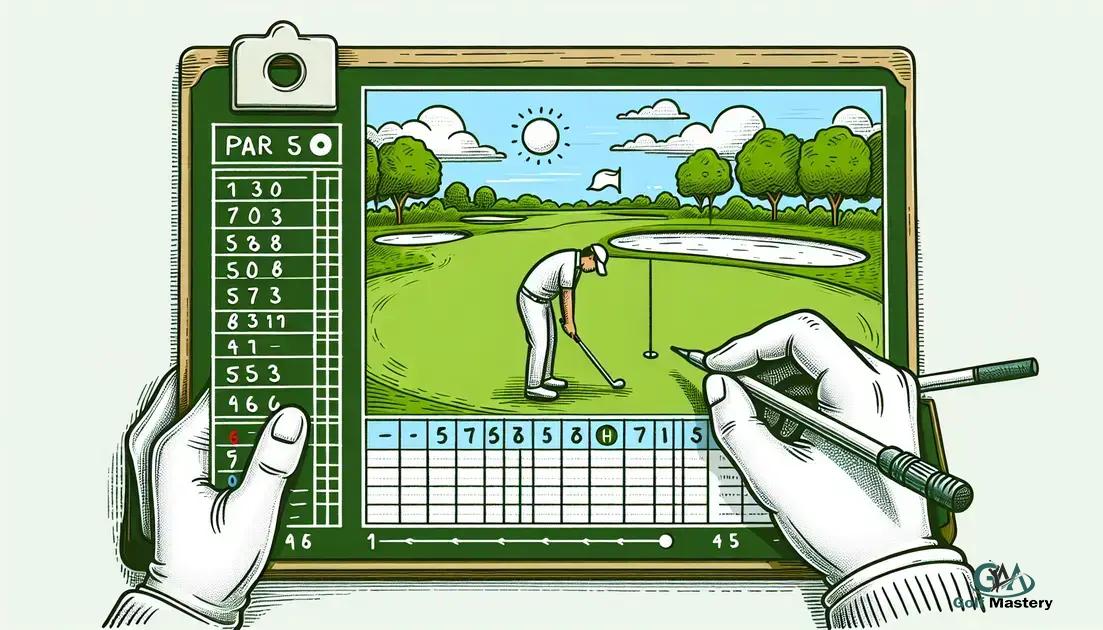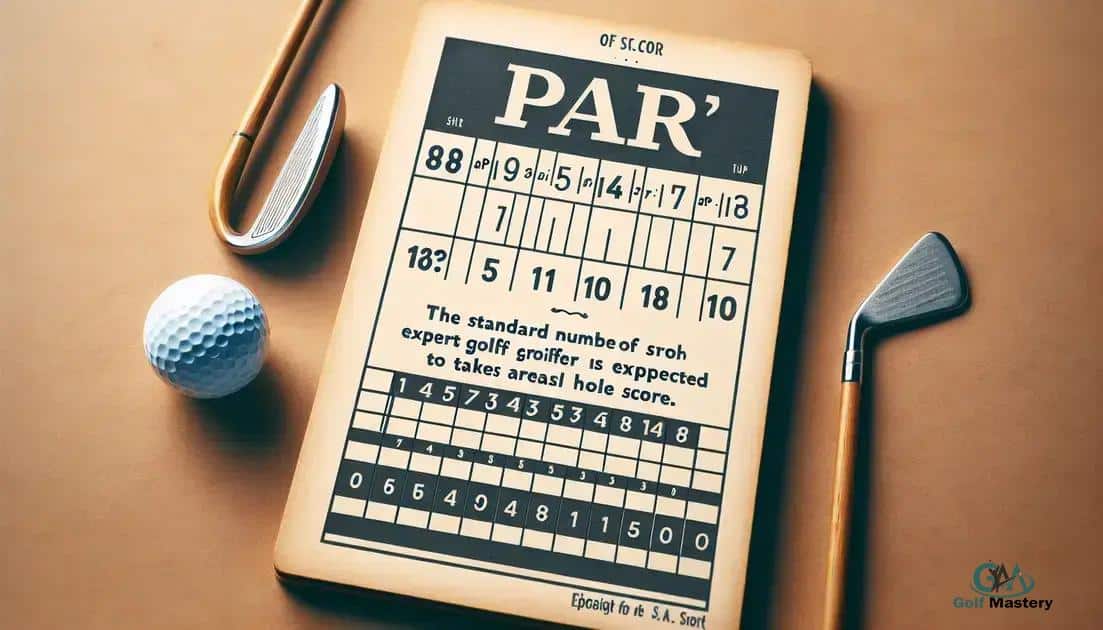What is par score in golf? Discover its significance, how it's calculated, and why it matters for every golfer's game.
Par score in golf is the expected number of strokes an expert golfer should take to complete a hole or course. Understanding and achieving par score helps golfers assess their performance, strategize effectively, and improve their overall game.
What is par score in golf? It’s a term that every golfer should know. Par reflects the number of strokes an expert player should require to complete a hole or a course. Understanding par score can enhance your golf strategy and improve your game. In this article, we will cover the basics of par score, explain its calculation, and discuss its significance in your golfing experience.
Understanding the Concept of Par Score
Par score is a fundamental concept in golf, and it describes the number of strokes an expert player is expected to take to complete a hole or an entire golf course. Each hole on a golf course has a designated par that accounts for its length and difficulty. For example, a par 3 hole should ideally take three strokes to complete, while a par 5 hole allows for five strokes.
What Defines Par?
The par for a hole is determined by various factors, including the length of the hole and its layout, which may feature hazards, bunkers, and undulating greens. In essence, par serves as a benchmark for golfers, helping them gauge their performance against an ideal standard.
Understanding Different Types of Par Score
It’s essential to know that par scores can vary. Most golf courses have a total par score, usually around 70 to 72 for an 18-hole course. Players often refer to this score when discussing their performance in the game. Deviation from par is expressed in terms of birdies (one stroke under par), eagles (two strokes under par), and bogeys (one stroke over par).
Why Par Score Matters
Understanding the concept of par score is important because it influences strategy and mindset on the course. Golfers use par as a target; aiming to equal or beat their par improves their skills and enhances their competitive spirit.
In conclusion, par score is not just a number; it is key to understanding the game of golf. Familiarity with par allows players to assess their performance accurately and to develop their golfing strategies effectively.
How Is Par Score Calculated?
Calculating par score in golf is relatively straightforward and involves a few key steps. The par score for each hole is usually predetermined by the golf course based on its length and difficulty. Here’s how it works:
Step 1: Evaluate the Hole Length
Each hole is classified into different categories based on its length: par 3, par 4, or par 5. For instance, a par 3 hole is typically up to 200 yards, a par 4 is between 200 and 450 yards, and a par 5 is more than 450 yards. Understanding these categories is essential to properly assess the par.
Step 2: Consider the Design of the Hole
The design, including hazards like water bodies and bunkers, also influences the par score. Golf courses are designed to challenge players while setting a standard that demonstrates expert play. A hole may have additional strokes added for obstacles that demand more skill.
Step 3: Total Par for the Course
The total par score for an 18-hole golf course generally ranges from 70 to 72. To calculate the overall par, simply add the par values of each hole. For example, a course with six par 3 holes, six par 4 holes, and six par 5 holes will have a total par of 72.
Example of Calculation
Let’s say a player encounters a course with the following holes: three par 3s (3 strokes each), eight par 4s (4 strokes each), and seven par 5s (5 strokes each). The calculation is:
(3 * 3) + (8 * 4) + (7 * 5) = 9 + 32 + 35 = 76
This specific course would have a total par score of 76. This helps players understand the overall expected performance level they should aim for while playing.
The Importance of Par Score in Golf
The importance of par score in golf extends beyond just a number; it serves multiple crucial roles for players of all levels. Understanding par can enhance your golfing experience and your score.
Benchmark for Performance
Par score establishes a standard for performance. When golfers know the par for each hole, they can better assess how well they are playing. It gives them a target to aim for, encouraging improved skills and strategies.
Encouragement for Improvement
Tracking your score against par helps golfers recognize where they excel and where they need to improve. For instance, if a player consistently makes bogeys but is targeting par, they can identify specific areas—like putting—that need attention.
Competitive Aspect
Par scores add a competitive element to the game. Golfers often compare their scores to par, which can add excitement to friendly matches and tournaments alike. A round of golf becomes more engaging when players strive to beat the par score, resulting in a healthier competitive spirit.
Courses Designed Around Par
Golf courses are intricately designed with par in mind. By understanding par score, players can navigate the course more effectively, tackling challenges strategically. This could involve choosing whether to play aggressively on a par 5 or conservatively on a par 3.
Measurement of Consistency
Finally, par score acts as a measure of consistency in a golfer’s game. Golfers who score near par consistently are generally considered skilled players. Over time, players can gauge their progress in improving to meet or beat their established par.
Real-World Examples of Par Scores
Real-world examples of par scores help demonstrate how golfers engage with the game across various courses. Here are a few notable instances:
1. Pebble Beach Golf Links
Pebble Beach, one of the most famous courses in the world, has a total par score of 72. The course features several par 3, par 4, and par 5 holes that present varying challenges. For example, the iconic 7th hole is a par 3 of only 106 yards, while the 18th is a par 5 that measures 543 yards from the back tees.
2. Augusta National Golf Club
At Augusta, home to the prestigious Masters Tournament, the par score is also 72. The course requires precise shots with its famously difficult greens. The 12th hole, known as Golden Bell, is a challenging par 3 that tests players’ skills and nerves.
3. St. Andrews Links
Often considered the birthplace of golf, St. Andrews has a par score of 72 for its Old Course. It features unique holes like the Road Hole, which is a par 4 that requires strategic play to avoid the road and hotel behind the green.
4. U.S. Open Courses
Various U.S. Open venues frequently push par scoring to new levels. For instance, the 2017 U.S. Open at Erin Hills had a par of 72, but it played tough with high wind and challenging conditions, leading to only a handful of players finishing close to par.
5. Local Municipal Courses
Even smaller municipal courses have significant examples of par scores. Many local public courses maintain a par score of 70 to 72, providing a solid benchmark for both beginners and experienced players. Understanding how to navigate these par scores can greatly enhance gameplay.
Tips for Achieving Your Par Score
Aiming to achieve your par score in golf requires strategy and practice. Here are some valuable tips to help you reach your goal:
1. Know the Course
Before you start your round, take time to learn the layout of the course. Understanding the layout, including hazards and distances, helps you plan your shots better. Many courses provide maps or scorecards that detail each hole’s par and yardage.
2. Focus on Short Game
A large part of scoring well comes from your short game. Spend time practicing chipping and putting, as these skills can make a significant difference in achieving your par score. Even small improvements in your short game can help you save strokes.
3. Manage Your Tempo
Consistency in your swing tempo is essential. Focus on swinging smoothly and at a controlled pace to increase accuracy. Practicing with a rhythm can lead to better results on the course.
4. Make Smart Decisions
Don’t always aim for the pin. Sometimes, playing it safe and aiming for the center of the green is better. Making smart decisions can prevent big mistakes, which helps you stay around your par score.
5. Set Realistic Goals
While aiming for your par score is great, setting realistic goals is just as important. Focus on gradual improvement over each round. For instance, if you usually score above par, aim to bring it down by a stroke or two before reaching par.
6. Practice Regularly
Consistency is key. Regular practice sessions will help you build the skills necessary to achieve your par score. Focus on all areas of your game: driving, approach shots, and short game.
7. Stay Positive
A positive mindset can significantly impact your performance. Stay focused on the shots you have made and keep a positive attitude when facing challenges on the course.
In Summary: Understanding Par Score in Golf
Understanding what par score in golf is can immensely improve your experience and performance on the course. The concept of par serves as a benchmark for your game, providing a clear target to aim for throughout your rounds.
From calculating par scores based on hole difficulty to recognizing the importance of these scores for strategy and improvement, all aspects contribute to your overall game. By examining real-world examples of famous golf courses and applying practical tips, golfers of all levels can work towards achieving their par scores.
Consistent practice, smart decision-making, and maintaining a positive mindset play crucial roles in reaching your target. Remember, each round presents an opportunity to enhance your skills and enjoy the game even more.
With dedication and the right strategies, you can master the art of achieving par and elevate your golfing experience.
FAQ – Frequently Asked Questions About Par Score in Golf
What is par score in golf?
Par score in golf is the number of strokes an expert golfer is expected to take to complete a hole or a golf course.
How is par score calculated?
Par score is calculated based on the length and difficulty of each hole. Holes are classified as par 3, par 4, or par 5.
Why is par score important for golfers?
Par score serves as a benchmark for performance, helping golfers gauge their skills and set improvement goals.
Can beginners achieve par score?
While it may take time, beginners can work towards achieving par scores through practice, strategy, and game management.
What tips can help me achieve my par score?
Key tips include knowing the course, focusing on the short game, making smart decisions, and practicing regularly.
Are there famous golf courses with notable par scores?
Yes, many famous golf courses like Augusta National and Pebble Beach feature par scores that are widely recognized in the golfing world.






Leave a Reply